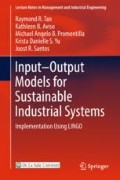Abstract
The interactions among groups of employees or staff in organizational units involve transactions that are analogous to those reflected in large-scale input–output models. The main difference is that, in an organization, the interactions of personnel with internal or external customers are often measured in terms of time (e.g., person-hours), in contrast to the monetary and physical units used in traditional input–output models. This chapter discusses organizational input–output models based on this concept. A case study is solved under different scenarios to illustrate the framework, and the corresponding LINGO model formulations are given.
Access this chapter
Tax calculation will be finalised at checkout
Purchases are for personal use only
References
Aviso KB, Mayol AP, Promentilla MAB, Santos JR, Tan RR, Ubando AT, Yu KDS (2018) Allocating human resources in organizations operating under crisis conditions: a fuzzy input-output optimization modeling framework. Resour Conserv Recycl 128:250–258
Aviso KB, Cayamanda CD, Mayol AP, Yu KDS (2017) Optimizing human resource allocation in organizations during crisis conditions: a P-graph approach. Process Integr Optim Sustain 1(1):59–68
Correa H, Correa V (1996) An application of input-output analysis to the administration of a library. Libr Inf Sci Res 18(4):343–356
Correa H, Craft J (1999) Input–output analysis for organizational human resources management. Omega 27(1):87–99
Correa H, Guajardo SA (2001) An application of input–output analysis to a city’s municipal government. Socio-Econ Plan Sci 35(2):83–108
Correa H, Parker BR (2005) An application of organizational input–output analysis to hospital management. Socio-Econ Plan Sci 39(4):307–333
Santos JR, Herrera LC, Yu KDS, Pagsuyoin SAT, Tan RR (2014) State of the art in risk analysis of workforce criticality influencing disaster preparedness for interdependent systems. Risk Anal 34(6):1056–1068
Author information
Authors and Affiliations
Corresponding author
Rights and permissions
Copyright information
© 2019 Springer Nature Singapore Pte Ltd.
About this chapter
Cite this chapter
Tan, R.R., Aviso, K.B., Promentilla, M.A.B., Yu, K.D.S., Santos, J.R. (2019). Input–Output Models of Organizational Structures. In: Input-Output Models for Sustainable Industrial Systems. Lecture Notes in Management and Industrial Engineering. Springer, Singapore. https://doi.org/10.1007/978-981-13-1873-3_9
Download citation
DOI: https://doi.org/10.1007/978-981-13-1873-3_9
Published:
Publisher Name: Springer, Singapore
Print ISBN: 978-981-13-1872-6
Online ISBN: 978-981-13-1873-3
eBook Packages: EngineeringEngineering (R0)

